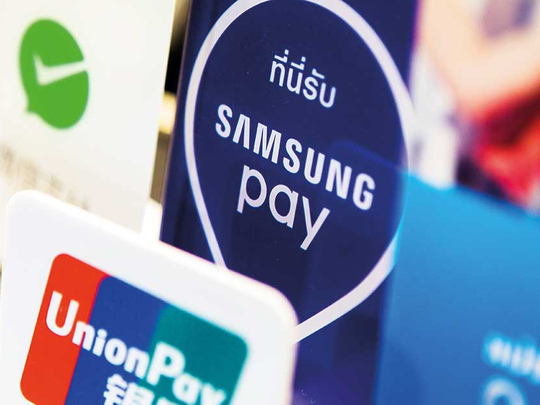
DUBAI
The hardest thing about using Samsung Pay, the mobile wallet, is explaining to every shopkeeper and barista that they can indeed take it as a payment method.
There is a moment when the member of staff serving you has finished ringing up your items on the register and produced the bill that they stare at you hopefully, expecting to be greeted by cash, or even a bank card.
If, in that moment, you present that person with your mobile phone, you will likely be met with a quizzical facial expression that is a mixture of fascination and disdain.
“You cannot pay for this iced latte with your mobile phone, Sir,” I was told on more than one occasion.
Rather than attempting to barter with my worldly possessions, however, I was trying to use Samsung Pay to, more figuratively than literally, pay with my mobile phone.
Samsung Pay, developed by the South Korean electronics giant to work on a number of its devices (I was using it on the recently-released Samsung Galaxy S8), was introduced in the UAE in April 2017.
Mobile wallets like Samsung Pay allow users to buy things with their mobile phone, by simply placing their phone next to, or on top of, a normal card reader.
This removes the need to carry cash or even bank cards.
To set up Samsung Pay, the user needs to link a bank card to the app, which then effectively enables the phone to act like that card when making purchases.
Samsung’s wallet can be used anywhere that you would usually swipe or tap your debit or credit card.
What this means is, the overwhelming majority of shops, restaurants, taxis, hotels, bars, and cinemas accept Samsung Pay. They probably just don’t know that they do.
Where Samsung’s mobile wallet differs to competitors such as Apple is that the South Korean company’s app works with card readers that have MST [Magnetic Secure Transmission], which according to some estimates is as high as 75 per cent in the UAE.
MST means a credit or debit card swipe on a standard card reader.
Apple’s mobile wallet only works with NFC [Near Field Communication] enabled card readers, which account for around 25 per cent of the market.
This means that of all the mobile wallet technologies on the market, Samsung’s has the widest adoption.
When using Samsung Pay, one definitely notices this. There are very few places which, after a bit of explanation about how you’re not trying exchange your mobile phone for a pack of chocolate biscuits, are still unable to accept Samsung Pay.
What follows the initial confusion when using Samsung Pay is a brief one-on-one educational seminar, where the user explains to the merchant how the app is actually quite simple, and proceeds to show them how easy it is to use.
Shopkeepers tend to be amazed that the system has worked successfully, and there is a genuine sense of achievement as you walk away with your purchases.
“I just paid for something using my phone,” I remember thinking the first few times I made purchases. There is something quite futuristic about it.
Once you get the hang of this procedure, and you’ve had the same conversations in shops a few times, the whole thing becomes incredibly straightforward. This process will only get smoother as Samsung continues its outreach to shop owners and other merchants, teaching them how to accept its mobile wallet.
There are, of course, things that could be improved with the app itself.
It remains quite rudimentary, and despite showing current promotions that are available to Samsung Pay users, really useful features like detailed spending habits are absent.
In fact, it only lists your past 10 transactions, meaning it isn’t very good for keeping track of expenses.
In the UK, mobile bank Monzo offers its users an in-depth analysis of their outlays, where they are spending the most amount of money and where they are best saving money, and a range of tools for budgeting, tracking, and calculating other costs.
The Samsung Pay app could take advantage of its insight in to your purchases by offering users more of these features.
Overall, however, the app is incredibly easy to use, widely adopted, and a gratifying experience that does truly feel like the future. Now, Samsung must do all it can to ensure that as many business owners as possible are aware they are living in it.












